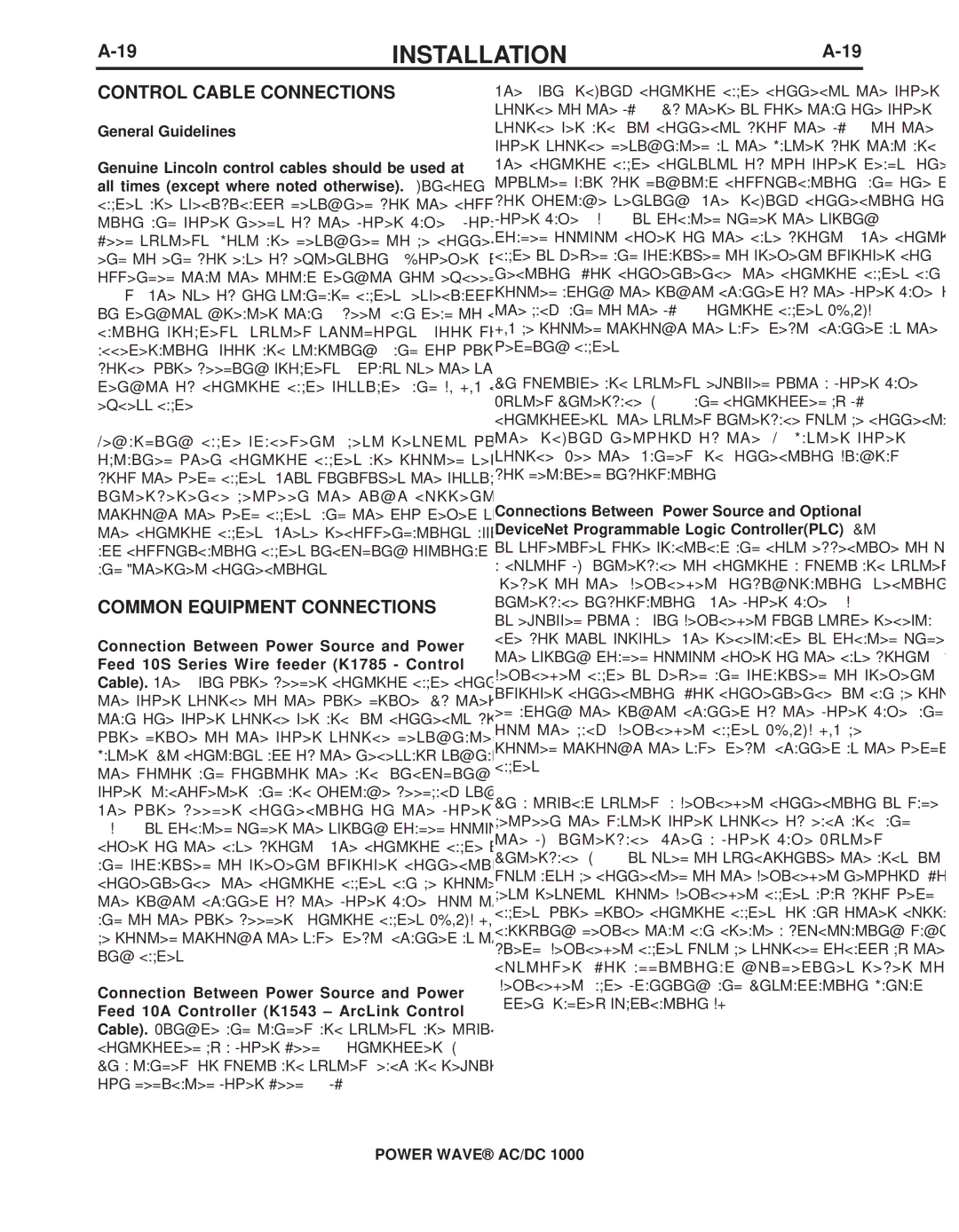CONTROL CABLE CONNECTIONS
General Guidelines
Genuine Lincoln control cables should be used at all times (except where noted otherwise). Lincoln cables are specifically designed for the communica- tion and power needs of the Power Wave / Power Feed systems. Most are designed to be connected end to end for ease of extension. However, it is rec- ommended that the total length not exceed 100 feet (30.5 m). The use of non-standard cables, especially in lengths greater than 25 feet, can lead to communi- cation problems (system shutdowns), poor motor acceleration (poor arc starting), and low wire driving force (wire feeding problems). Always use the shortest length of control cable possible, and DO NOT coil excess cable.
Regarding cable placement, best results will be obtained when control cables are routed separate from the weld cables. This minimizes the possibility of interference between the high currents flowing through the weld cables, and the low level signals in the control cables. These recommendations apply to all communication cables including optional DeviceNet and Ethernet connections.
COMMON EQUIPMENT CONNECTIONS
Connection Between Power Source and Power Feed 10S Series Wire feeder (K1785 - Control Cable). The 14-pin wire feeder control cable connects the power source to the wire drive. If there is more than one power source per arc, it connects from the wire drive to the power source designated as the Master. It contains all of the necessary signals to drive the motor and monitor the arc, including the motor power, tachometer, and arc voltage feedback signals. The wire feeder connection on the Power Wave AC/DC 1000 is located under the spring loaded output cover on the case front. The control cable is keyed and polarized to prevent improper connection. For convenience, the control cables can be routed along the right channel of the Power Wave, out the back, and to the wire feeder. Control cables SHOULD NOT be routed through the same (left) channel as the weld- ing cables.
Connection Between Power Source and Power Feed 10A Controller (K1543 – ArcLink Control Cable). Single and tandem arc systems are typically controlled by a Power Feed 10A Controller (K2362-1). In a tandem, or multi-arc system, each arc requires its own dedicated Power Feed 10A (PF-10A).
The 5-pin ArcLink control cable connects the power source to the PF-10A. If there is more than one power source per arc, it connects from the PF-10A to the power source designated as the Master for that arc. The control cable consists of two power leads, one twisted pair for digital communication, and one lead for voltage sensing. The ArcLink connection on the Power Wave AC/DC 1000 is located under the spring loaded output cover on the case front. The control cable is keyed and polarized to prevent improper con- nection. For convenience, the control cables can be routed along the right channel of the Power Wave, out the back, and to the PF-10A. Control cables SHOULD NOT be routed through the same (left) channel as the welding cables.
In multiple arc systems equipped with a Power Wave System Interface (K2282-1), and controlled by PF-10A controllers, the system interface must be connected to the ArcLink network of the ARC1 Master power source. See the "Tandem Arc Connection Diagram" for detailed information.
Connections Between Power Source and Optional DeviceNet Programmable Logic Controller(PLC). It is sometimes more practical and cost effective to use a custom PLC interface to control a multi-arc system (refer to the "DeviceNet Configuration" section for interface information). The Power Wave AC/DC 1000 is equipped with a 5-pin DeviceNet mini style recepta- cle for this purpose. The receptacle is located under the spring loaded output cover on the case front. The DeviceNet cable is keyed and polarized to prevent improper connection. For convenience, it can be rout- ed along the right channel of the Power Wave, and out the back. DeviceNet cables SHOULD NOT be routed through the same (left) channel as the welding cables.
In a typical system, a DeviceNet connection is made between the master power source of each arc, and the PLC interface. When a Power Wave System Interface (K2282-1) is used to synchronize the arcs, it must also be connected to the DeviceNet network. For best results, route DeviceNet cables away from weld cables, wire drive control cables, or any other current carrying device that can create a fluctuating magnetic field. DeviceNet cables must be sourced locally by the customer. For additional guidelines refer to the "DeviceNet Cable Planning and Installation Manual" (Allen Bradley publication DN-6.7.2).
